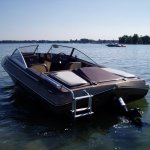My Diplomat seems to be sitting really low and seems like and carrying extra weight. I suspect possibly wet foam. But I don’t know what is normal. I have a photo of the bulkhead at the front of the engine compartment but I can’t get it to attach because it’s too large. There are two holes about 3/4 in diameter. Are those supposed to be there? Are they drain holes?
Last Summer I forgot the drain plug and the boat took on a lot of water while I parked the trailer. Water could have travelled up those holes. But over the Winter maybe dried back out?
Anyway - I really don’t want to tear the whole floor out. Is there a way to check for the issue? And if it is wet, could I dry it over the off season and then should I seal up those holes?
Finally - those boxes on either side of the engine - those could be wet too right? Could those be ripped out and redone without messing with the rest of the floor?
PS - if anyone has a photo of an ‘82 Diolomat in the water (just sitting) so I could compare how low it sits that would be helpful!
Last Summer I forgot the drain plug and the boat took on a lot of water while I parked the trailer. Water could have travelled up those holes. But over the Winter maybe dried back out?
Anyway - I really don’t want to tear the whole floor out. Is there a way to check for the issue? And if it is wet, could I dry it over the off season and then should I seal up those holes?
Finally - those boxes on either side of the engine - those could be wet too right? Could those be ripped out and redone without messing with the rest of the floor?
PS - if anyone has a photo of an ‘82 Diolomat in the water (just sitting) so I could compare how low it sits that would be helpful!




